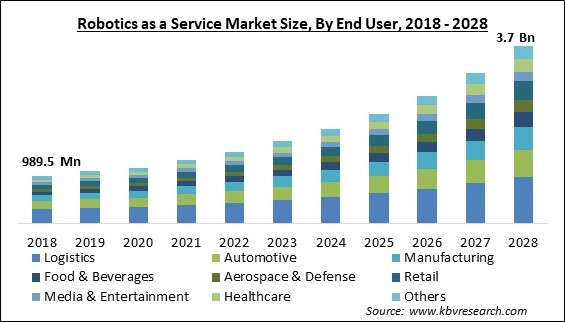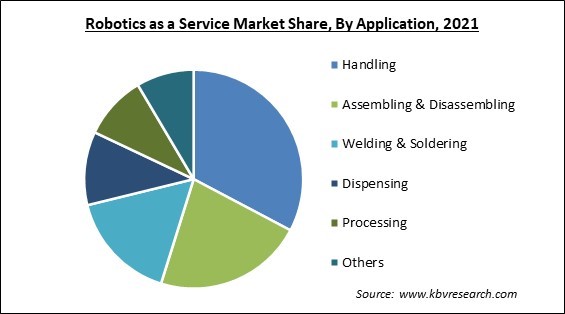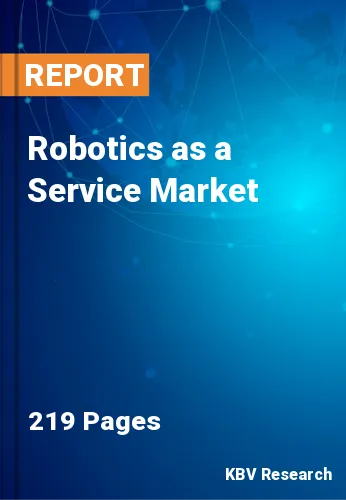The Global Robotics as a Service Market size is expected to reach $3.7 billion by 2028, rising at a market growth of 16.3% CAGR during the forecast period.
Robot as a Service or RaaS is a cloud computing service that makes it possible to integrate robots and other embedded devices into internet and cloud computing ecosystems without any noticeable performance hit. RaaS is advantageous for both consumers and robotic businesses. By leasing robotic equipment and leveraging a cloud-based subscription service, robots as a service enable organizations to benefit from robotic process automation (RPA). This technology's main benefit is that it lessens the requirement for manual IT assistance while enhancing the effectiveness of robotic processes.

Three things are necessary for the deployment of a RaaS in an organization. First, the use of appropriate tools to control the RaaS. The second is to determine the specific degree of services the company requires. The last is to choose a vendor to support the RaaS. X-as-a-Service business models, which supply a specific service instead of a new product to execute the service, are already widespread in the sector. The biggest change in models like this is substituting a billing structure based on the services rendered rather than the product itself for a proportionately high up-front product price.
This is especially true for robotics because users of RaaS business models can access a cloud-based subscription facility and lease robotic devices to gain the advantages of robotic process automation (RPA) rather than buying the hardware outright. RaaS eliminates the hassles of ownership, like paying off a costly piece of equipment and resolving unexpected maintenance needs.
Agile and lean processes are always desired in many industries; businesses should be able to quickly alter operations or output in accordance with market developments. RaaS enables quick changes in product kinds, such as moving swiftly from grid-based "shelve-to-person" automated guided carts (AGCs) to "carton-to-person" case-picking robots. In addition, customers can start or stop mobile robotic systems at any moment as needed. RaaS makes it possible to scale the fleet size more easily and conveniently without worrying about the dangers of future fleet size reductions.
The manufacturing curve for semiconductors and electronics also flattened but stayed steady after the pandemic. Additionally, because of the COVID-19 outbreak, there has been an increased focus on reducing hospital-acquired infections, encouraging the adoption of robots for cleaning and sanitation tasks. Robotic technologies, like cleaning and disinfection maintenance robots, were used to combat COVID-19. Increasing uninfected demand gave service robots a new home in this field. Most manufacturers authorized new disinfection robots as a result. The adoption of industrial robots has also reportedly benefited several manufacturing enterprises. Therefore, the pandemic favorably impacted robotics as a service market.
The usage of robotic systems and automation has gradually increased because of labor scarcity and the need to reduce costs. For instance, autonomous forklifts are predicted to be driven by rising warehouse rents and dwindling warehouse availability. In addition, automated handling replaces human interaction in routine tasks, including accurate item storage at a predetermined location, item retrieval, and damage-free delivery of products to certain processing or interface points. Hence, using autonomous forklifts optimizes space utilization while lowering labor expenses. Therefore, the lower costs of operation of robotics and subsequent increase in profits, in the long run, are the primary factors boosting the growth of the robotics as a service market.
The rising use of robots in production facilities worldwide has led to a steady increase in demand for cloud robotics. Cloud robotics aims to integrate system intelligence with the production robots already in place. A high-performance network like 5G, which offers better bandwidth and reduced latency than Wi-Fi, is now required due to the increased usage of cloud robotics in the industrial industry. Real-time video and large dataset activities are supported by 5G. Because it makes it simple to integrate factory-deployed robots with the cloud network, it is becoming more popular in robotics. The market for robotics as a service will grow in the upcoming years due to all these factors.

Companies must employ skilled engineers as well as programmers to supervise the deployment of robots since they need expert coding and training to carry out jobs. On top of that, when novel software is created, or new robots hit the market, even experienced staff members may require retraining. Moreover, robotic systems must have the temporal, physical, spatial, and social awareness that can be better handled by a wide range of approaches and technologies due to the complexity of difficult real-world tasks. As a result, the market's growth in the upcoming years may be hampered by the lack of contact caused by the complexity of these systems.
On the basis of application, the robotics as a service market is divided into handling, assembling & disassembling, dispensing, processing, welding & soldering, and others. The handling segment acquired the largest revenue share in the robotics as a service market in 2021. The rapid use of RaaS in the logistics industry is responsible for the segment's growth. Automating repetitive processing processes like polishing and burring, used in the automotive, plastics, rubber & chemicals, and wood sectors leads to optimal processing. These processing applications are typically carried out by SMEs in their manufacturing facilities. The use of RaaS to automate processing operations is anticipated to increase during the projected period due to the rapid expansion of large-scale industries.
Based on end user, the robotics as a service market is segmented into manufacturing, automotive, aerospace & defense, logistics, healthcare, retail, food & beverages, media & entertainment, and others. The manufacturing segment procured a remarkable growth rate in the robotics as a service market in 2021. The growing trend of autonomous procedures in factories and industries has accelerated the segment's growth. Factories frequently use RaaS systems to improve productivity and streamline processes. They can lessen time limitations and error rates as a result. Even for small companies, the growing usage of robotic systems has greatly reduced operational expenses, accelerating the adoption of RaaS.
| Report Attribute | Details |
|---|---|
| Market size value in 2021 | USD 1.3 Billion |
| Market size forecast in 2028 | USD 3.7 Billion |
| Base Year | 2021 |
| Historical Period | 2018 to 2020 |
| Forecast Period | 2022 to 2028 |
| Revenue Growth Rate | CAGR of 16.3% from 2022 to 2028 |
| Number of Pages | 219 |
| Number of Table | 353 |
| Report coverage | Market Trends, Revenue Estimation and Forecast, Segmentation Analysis, Regional and Country Breakdown, Companies Strategic Developments, Company Profiling |
| Segments covered | Application, End User, Region |
| Country scope | US, Canada, Mexico, Germany, UK, France, Russia, Spain, Italy, China, Japan, India, South Korea, Singapore, Malaysia, Brazil, Argentina, UAE, Saudi Arabia, South Africa, Nigeria |
| Growth Drivers |
|
| Restraints |
|
On the basis of region, the robotics as a service market is analyzed across North America, Europe, Asia Pacific, and LAMEA. The North America segment witnessed the highest revenue share in the robotics as a service market in 2021. In North America, small and medium-sized businesses mostly utilize robotics as a service. One of the biggest markets in the region for RaaS is the United States. Robotics is becoming more prevalent in the automobile industry with the introduction of hybrid and electric vehicles. Growing North American businesses are investigating using robots to carry out unpleasant and hazardous tasks.
Free Valuable Insights: Global Robotics as a Service Market size to reach USD 3.7 Billion by 2028
The market research report covers the analysis of key stake holders of the market. Key companies profiled in the report include Berkshire Grey, Inc., Kuka AG (Midea Investment Holding Co., Ltd.), Cyberdyne, Inc., Knightscope, Inc., Locus Robotics, Exotec SAS, Caja Robotics, Hirebotics, Cobalt Robotics and Relay Robotics, Inc.
By Application
By End User
By Geography
The global Robotics as a Service Market size is expected to reach $3.7 billion by 2028.
Reduces costs over time and prevents obsolescence are driving the market in coming years, however, Absence of connection between robots & human workforce restraints the growth of the market.
Berkshire Grey, Inc., Kuka AG (Midea Investment Holding Co., Ltd.), Cyberdyne, Inc., Knightscope, Inc., Locus Robotics, Exotec SAS, Caja Robotics, Hirebotics, Cobalt Robotics and Relay Robotics, Inc.
The expected CAGR of the Robotics as a Service Market is 16.3% from 2022 to 2028.
The Logistics segment is leading the Global Robotics as a Service Market by End User in 2021 thereby, achieving a market value of $982.7 million by 2028.
The North America market dominated the Global Robotics as a Service Market by Region in 2021, and would continue to be a dominant market till 2028; thereby, achieving a market value of $1.3 billion by 2028.
Our team of dedicated experts can provide you with attractive expansion opportunities for your business.

